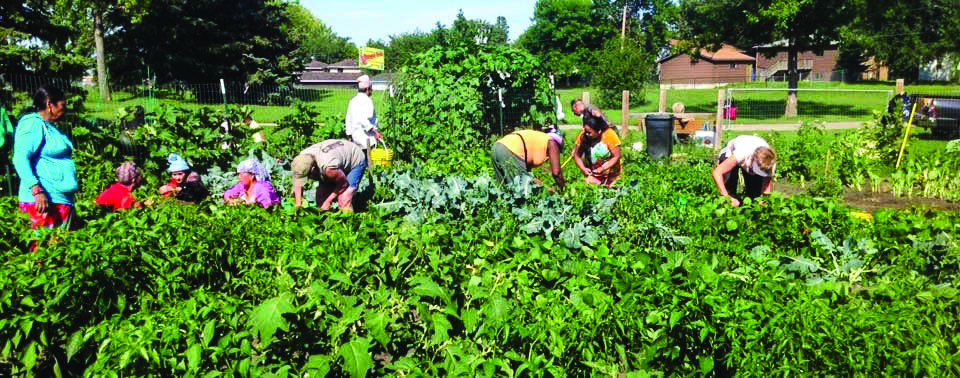From Extra-ordinary living magazine Fall 2023
Nancy Edmonds Hanson

Watching the garden grow is, for most, a solitary pleasure. Not so for the hundreds of volunteers who have been spending their hours this summer planting seeds, plucking weeds and now picking the bounty produced in eight spacious gardens tucked into unexpected corners of Fargo.
When public land is opened up to gardeners, they’re usually assigned their own private plots. Growing Together Community Gardens does it differently. For the past 18 summers, the nonprofit program has attracted troupes of planters and tillers and weeders, who donate two hours or so every week from planting time to the peak of harvest.
“You work – you eat,” founder Jack Wood smiles. “We’re not just growing healthy food. We grow relationships.”
The Growing Together model was something new when the seed was planted back in 2005. It grew out of a discussion at Olivet Lutheran Church between a pastor, a church president and a school principal about how to serve Fargo’s growing New American population. Gardening, they realized, is practiced around the globe, not only meeting the need to feed families, but sowing the connections that build communities.
Jack Wood was a natural to head the project; his email, jackstomatoes@gmail.com, hints at why he was tapped. Along with school social worker Nola Storm, he put together the first season on a 100-by-100-foot plot behind the church. Eight families took on separate plots that year. Another section, though, was tended communally by a group of volunteers.
“At the end of the summer, we noticed that the areas we worked together did much better than the individual plots,” Jack remembers. Thus was born the principle that has propelled Growing Together ever since: Shared work, shared harvest.
In its early seasons, Growing Together counted on a corps made up of 75% New Americans (then primarily Liberian and Bhutanese) and 25% of what Wood calls “not-new Americans.” Over the years, the percentages have flipped, with a growing number of Afghans and Ukrainians joining their ranks.
The work – and the rewards – are, as always, open to all. Jack and the gardens’ supervisors are always on the look-out to recruit new helpers, both seasoned green thumbs and greenhorns new to the pleasures of growing.
Many of the gardeners have decades of experience in their own back yards, knowledge they’re eager to share with younger generations. Others, though, come on board to be inspired. “We’re reaching out to more 25- to 35-year-old who want to learn about gardening,” he reports. Some volunteers have been part of the garden project for most of its history. Others come and go … taking away the knowledge they need to raise their own home gardens, or setting out to apply the principles they have learned in other community gardening enterprises.
To qualify for a share of the harvest, volunteers agree to donate at least 20 hours of work between May and September. Two-hour shifts are scheduled weekly at each of the gardens. The growing spaces are donated by churches and private businesses or allocated in Fargo parks. Wood keeps in touch with his troupe through weekly email newsletters that highlight special opportunities to help, both in the garden and in weekly meals prepared and served at the New Life Center.
Their yield is enormous. In 2022, 288 volunteers donated more than 6,600 hours of labor, ultimately harvesting almost 52,000 pounds of fresh, nutritious produce. Most of it was shared by the gardeners, but there was more than enough to satisfy their appetites. Some 8,000 pounds of veggies was also donated to local food shelves. This year the numbers appear to be even greater.
Besides feeding families participating in the gardens and donating to food banks, fresh vegetables are available for sale every Tuesday afternoon through mid-October near the Gethsemane Grace Garden at 3600 25th St S. These extras are raised in the program’s Market Garden – a source of support for the nonprofit project, which also depends on charitable grants and donations from businesses and individuals.
Other produce takes a proud place on the menus of periodic international dinners hosted by Growing Together. This year’s first was on Aug. 16; the second, featuring indigenous culture and foods, is coming up Sept. 13.
Right now, when gardeners across the community are bursting with pride at the piles of produce their often back-breaking labor has engendered, the Growing Together community is justifiably proud of its bounty of plump, delicious crops. But while it’s rooted in the soil, the gardens’ greatest benefit has branched much farther afield. Working side by side, through sun and rain, blossoms into deep connections and lasting friendships.
And in the end, that’s what makes the gardens grow. Observes Jack Wood, echoing age-old wisdom: “Many hands make light work.

